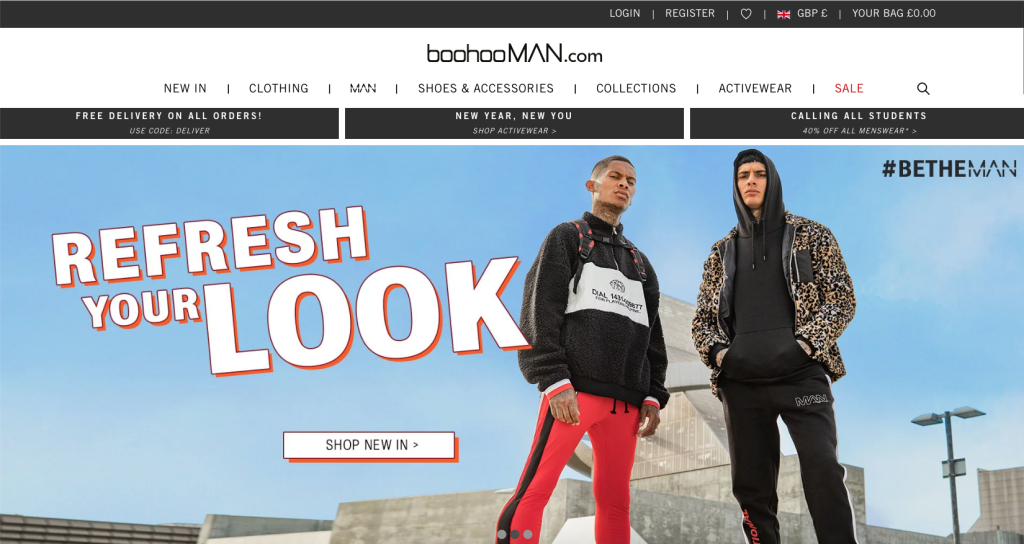In the United Kingdom alone there are more than 45 million e-commerce users, with another 4 million expected to start shopping online by 2021.
According to Statista, we’re expected to spend an eye-watering US$93 billion this year – increasing to US$113.64 million by 2023.
Whether you operate in the fashion industry (online fashion sales will hit $25 billion in 2019) or you sell products from your bricks and mortar business online, it’s impossible not to have a digital presence.
But after spending thousands of pounds setting up an e-commerce store for your business, what can you do if you’re struggling to generate sales and make a profit?
The average e-commerce conversion rate is currently just 1-2% – for every 100 that visit your website, just one or two will convert into a customer.
The good news, though, is that there are ways to increase conversion rates and generate more sales – but it requires hard work.
Below, we’ve put together five of the most effective e-commerce conversion rate optimisation techniques to consider in 2019 and beyond.
Use high-quality images and video
Your website is the shopfront of your business online, and every product page is a page from your catalogue.
Think about the way you’re presenting your products and consider investing in a photographer or videographer to create a new batch of images that are more appealing.
The truth is that your iPhone camera simply won’t cut it if you’re trying to sell hundreds or even thousands of products and want to be taken seriously online.
You need high-quality, visually appealing images on your site, whether you’re selling car parts or chocolate bars.
If your images don’t help users visualise the product, then you’re unlikely to sell many of them.

The Scotland Shop features visually stunning images of their clothing in magazine-style shoots. Consider something similar, but be careful not to be too artsy.
Offer free delivery
According to EcommerceNews, Amazon has a 16% e-commerce market share in the United Kingdom – although that figure is expected to rise in the coming years.
One reason why Amazon dominates the e-commerce landscape (it accounts for 50% of all online sales in the US) is because it offers a compelling product: low-cost merchandise and free delivery.
Online shoppers have come to expect free or cheap delivery when they buy goods and services online – and if you’re charging a £4.99 delivery fee on orders, then your shoppers are more likely to abandon their carts and shop with one of your competitors.
If you’re worried you cannot afford to offer free shipping, then review your profit margins and add a pound or two to your products to cover the costs.
You could set a minimum order for free shipping to encourage shoppers to add more to their baskets or run limited-time offers.

Clothing e-commerce brands like Boohoo are known for limited-time delivery promos.
Review your checkout process
When was the last time you reviewed your online checkout process?
If you’re struggling to get users to buy from you, the chances are that your checkout is too longwinded.
In today’s fast-paced world, customers want to be able to buy products at the click of a button – and particularly on mobile, they don’t want to spend all day typing in information on your checkout elements.
Keeping it simple is the key to securing more e-commerce orders.
According to Baymard, 26% of all shoppers have abandoned an online cart simply because the checkout process was too long or complicated.
Their data also shows that checkouts, on average, have 23 form elements (name, address, email, password, etc), when in reality firms can get all of their necessary information in as little as 12 form elements.
Limit the amount of information you request from customers when they make a purchase, and they’ll buy more.
If you want to further streamline your checkout process, run A/B tests to determine the best user experience, and integrate payment methods such as Apple Pay to eliminate form filling.

Apple Pay and Google Pay allow vendors to take payments without asking for an email address, credit card number, or shipping address. It reduces the headache of buying online and increases conversions – provided that it’s used correctly.
Try cart abandonment software
If you’re getting lots of abandoned shopping carts (for example, a customer visits your site, adds products to their shopping basket and then leaves without buying), you should think about installing abandoned cart software to encourage those buyers to return to your site.
The software allows you to send reminder emails to customers, giving them the heads up that their products are waiting for them.
You can sweeten the deal and further encourage conversions by offering a discount code – as little as 5% off is enough incentive for many.
Abandonment software can also integrate with your pay-per-click and social media adverts so that you can effectively ‘follow users around the web’ and remarket your products to them.
Remarketing can be incredibly effective, but be mindful of the fact that some customers do not like this form of advertising, so it could have a negative impact on your brand reputation.
Show you’re security conscious
Online shoppers have never been more conscious over the misuse of their personal data, so it’s your responsibility to show them you care about keeping their information safe and out of harm’s way. If you’re a new e-commerce brand, then it’s even more important to build trust.
Start by installing an SSL certificate across your entire website, and consider a security badge, whether that be GeoTrust, McAfee, or Google Shopping to verify your security features and encourage users to hand over their information.
Badges can increase trust and demonstrate your commitment to protecting data, so sign up with as many as you like.
Next, add payment methods, like credit cards, PayPal, Google Pay and Apple Pay, which will serve as a visual sign that you use only trusted payment vendors, and make sure that your privacy policy page is GDPR compliant, easy to read and written in Plain English.
Wrapping up
There are countless methods to increase conversions on e-commerce sites – we’ve only just scratched the surface with the techniques featured in this article.
If you’re looking to increase sales and take your e-commerce business to the next level, contact the UK conversion rate optimisation experts here at Zudu, who can help you convert traffic into profit.





